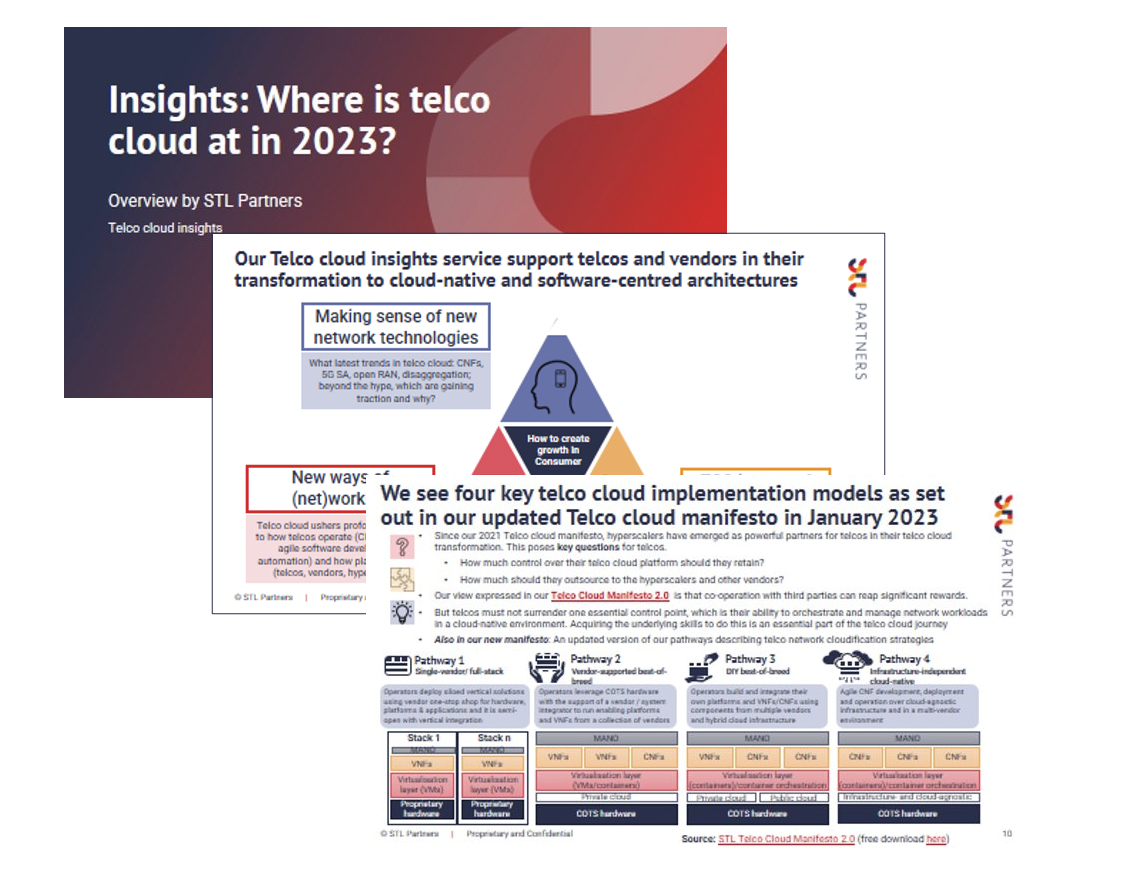
SD-WAN Solutions: Exploring Telco vs. Non-Telco Approaches and Their Differences
Enterprises looking into SD-WAN solutions have two primary options: adopting through telco providers or exploring offerings from non-telco vendors. Each pathway presents its own set of benefits, which this article will explore in more detail.
What are SD-WAN solutions?
Software-Defined Wide Area Network (SD-WAN1) is a networking technology that simplifies the management and operation of a wide area network (WAN) by separating the network control plane from the data forwarding plane, allowing for centralised control of IP data flows across the WAN using Software Defined Networking (SDN) techniques. This software-defined management ‘overlay’ can be more or less integrated with the underlying hardware (or underlay). Equally, the network functions that SD-WAN leverages – typically including firewalls, VPNs/IPsec, and edge and core routing – are more or less virtualised and disaggregated from the hardware appliances involved.
SD-WAN emerged in the early 2010s as a response to the need for more agile and cost-effective WAN solutions. Initial deployments took place in North America and as the technology matured, it spread globally, reaching Europe, Asia-Pacific, and other regions. SD-WAN offers numerous benefits for organisations, including enhanced network performance, cost savings through efficient connectivity options, simplified network management, flexibility, and scalability, which has allowed it to become a key technology for modern networking needs.
There are two main ways for enterprises to obtain SD-WAN, either from telco providers or from non-telco vendors. The figure below summarises the benefits inherent to each approach.
Benefits of SD-WAN solutions: Telco SD-WAN vs. non-telco SD-WAN

Benefits of sourcing SD-WAN services from telcos
Enterprises can procure SD-WAN services directly from telcos that offer SD-WAN solutions as part of their portfolio. There are several benefits of telco SD-WAN.
- Vendor management: By obtaining SD-WAN services from a telco, enterprises can reduce the complexity of dealing with multiple vendors. Telcos act as a single point of contact, managing vendor relationships, and streamlining the support and maintenance process.
- Network integration: Telcos can integrate SD-WAN services (the SD-WAN overlay) with existing network infrastructure and services (the underlay), including MPLS and other connectivity options. This enables enterprises to leverage their existing investments and transition to SD-WAN without disrupting their existing network operations.
- Scalability and flexibility: Telcos have the resources and infrastructure to scale SD-WAN services according to enterprise needs. They can offer flexible bandwidth options, accommodate peak demand, and adjust network capacity as required, providing enterprises with agility and scalability.
- Simplified management: Telcos can provide end-to-end management of the SD-WAN solution, handling tasks such as deployment, configuration, monitoring, and troubleshooting. This relieves the burden of managing the infrastructure and fits in with established managed services business models and relationships.
- Service Level Agreements (SLAs): Telcos offer SLAs that guarantee service availability, performance, and support response times. This provides enterprises with assurance and accountability regarding the quality of their SD-WAN services.
Telcos typically offer SD-WAN products from several vendors
Verizon is one of the telcos that offer directly managed SD-WAN. Operating in 150 different countries, Verizon has a global footprint, which allows enterprises with operations in multiple countries to benefit from consistent connectivity. However, the company’s focus is primarily within its domestic market, making it a good option for business with most branches in North America. In our latest Telco Cloud Deployment Tracker, we have logged eleven SD-WAN or SASE deployments for Verizon. These span the 2015-2023 period and have involved six different vendors. The most deployments were with Cisco and involved Cisco Meraki, Cisco Viptela and Cisco IWAN.
Similarly to Verizon, BT also has a global footprint, with operations in approximately 180 countries. However, the provider’s network and coverage are most robust in the UK and Europe, making it a good choice for enterprises with a majority of operations in that region. BT has different offerings for SMEs and global enterprises, which allows for service differentiation and improved customer support. Still according to our tracker. BT is the second most active telco on the SD-WAN market with nine deployments over the 2016-2022 period, through partnerships with Cisco, VMware, Nokia (Nuage), Fortinet and Infovista.
Deutsche Telekom is another telco actively marketing SD-WAN/SASE services (seven deployments logged in our tracker). What is interesting about DT is that for a while, it had a strong focus on Germany and lacked global infrastructure to be able to offer more international services. However, the company’s recent investment in Teridion Technologies, an Israeli multi-cloud WAN connectivity solutions provider which operates a virtual software-defined network, has given DT access to 500 points of presence globally, thus allowing Deutsche Telekom to significantly broaden its service portfolio globally.
Top 10 SD-WAN/SASE telco providers by number of deployments and by vendor, 2015-2023

Source: Telco Cloud Deployment Tracker
Benefits of sourcing SD-WAN services directly from vendors
Alternatively, enterprises can choose to source their SD-WAN services from specialist non-telco vendors . Currently, vendors providing SD-WAN independently have a larger share of the market than operators. These vendors offer a variety of SD-WAN products and platforms that can be implemented by the organisation’s IT teams or with the assistance of professional services. Benefits for enterprises of obtaining SD-WAN directly from non-telco vendors include:
- Vendor choice: There is a great variety of non-telco SD-WAN vendors, offering a wide range of solutions. As such, enterprises have the freedom to choose the SD-WAN vendor that best fits their specific needs in terms of features, functionalities, and compatibility with existing network infrastructure.
- Integration with multi-vendor environments: As they are often based on a software overlay, non-telco SD-WAN solutions are designed to interoperate with multi-vendor environments and multi-operator networks, allowing enterprises to leverage their existing network infrastructure investments. This flexibility is particularly beneficial when organisations have diverse networking equipment or use different service providers across their locations.
- Innovation and agility: Non-telco SD-WAN providers often prioritise innovation and agility. They are quick to adopt emerging technologies, introduce new features, and respond to market demands. This can result in faster access to the latest advancements and capabilities in SD-WAN.
- Cost optimisation: Non-telco SD-WAN solutions often provide cost optimisation opportunities. Enterprises can choose vendors and deployment models that more closely align with their budget and operational requirements. This flexibility enables cost-effective scaling, bandwidth allocation, and the ability to prioritise critical applications without being tied to a specific telco pricing structure.
- Customisation and specialisation: Non-telco SD-WAN providers may offer specialised features and customisation options tailored to specific industry verticals or unique enterprise requirements. This allows enterprises to fine-tune the SD-WAN solution to their specific needs, optimising network performance and addressing specific business challenges.
New players have emerged in the SD-WAN/SASE market
In our previous article 8 Leading SD-WAN Providers: A Comprehensive Analysis we have provided a comparative overview of the leading SD-WAN providers. These are all still relevant today, but some new players have emerged, such as Zscaler and Cato Networks.
Zscaler is a cloud security company. While Zscaler does not offer SD-WAN directly, the company’s Secure Service Edge (SSE) platform integrates with more than a dozen leading SD-WAN providers, including Aruba, Cisco, Juniper and VMware, to offer secure access to cloud-based apps from any device or location, over any network.
Cato Networks offers a cloud native SD-WAN-as-a-service solution, which includes a complete set of networking and SASE security features delivered from the cloud. The company is bundling a global private backbone consisting of over 70 points of presence (PoPs) globally with its SD-WAN. Cato’s cloud native SD-WAN is part of Cato’s broader SASE platform.
These new vendors, like the more established ones listed in the aforementioned article, predominantly sell directly to the enterprise sector but can also choose to partner with telcos to go to market. Such partnerships include (still according to our tracker): KDDI in Japan for Cato Networks in 2021 and Liberty Global and Verizon for Zscaler.
Download this article as a PDF
Read more about Telco Cloud
Telco cloud insights pack
This document will provide you with the latest insights from our research and consulting work, including some extract of our Telco Cloud Manifesto 2.0, and our latest analysis on open RAN.
What is SASE?
SASE is a cloud-based networking platform designed to secure decentralised networks that connect users, applications & devices from anywhere.
8 Leading SD-WAN Providers: A Comprehensive Analysis
With several, complex SD-WAN offerings available and different players able to provide on-demand SD-WAN and multi-cloud networking capabilities, the SD-WAN ecosystem and market is becoming an increasingly interesting area and a potential battleground. This article provides an overview of the leading SD-WAN providers.
SD-WAN vs MPLS: Will SD-WAN lead to the demise of MPLS?
When SD-WAN first came along, there was a lot of hype surrounding it; people said it was far superior to MPLS and that its rise would lead to the ‘death’ of MPLS. However, this so far hasn’t happened. In order to understand why, and if one is in fact better than the other, it’s important to understand what the difference is between the two.





